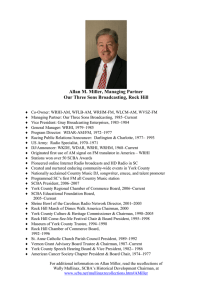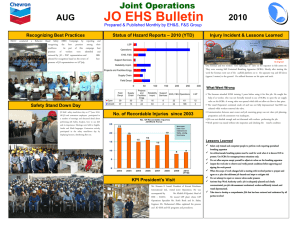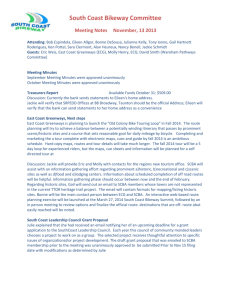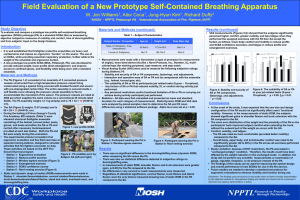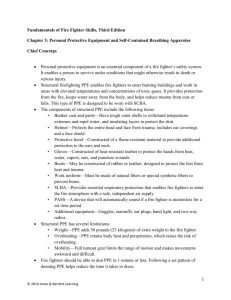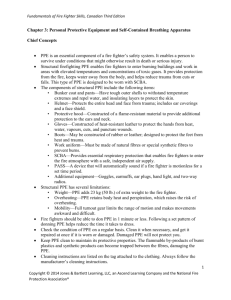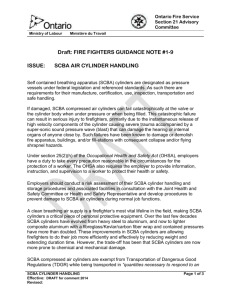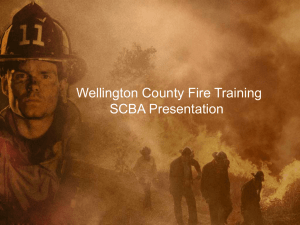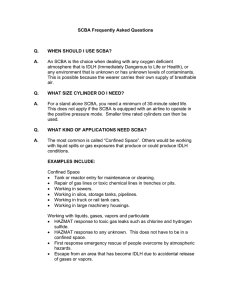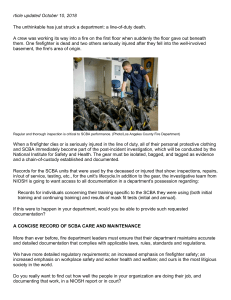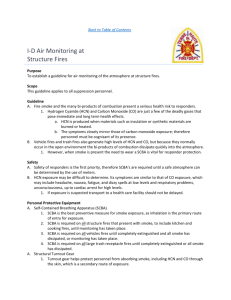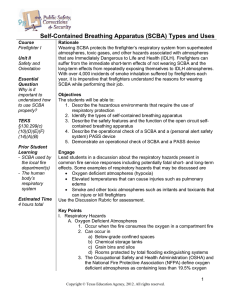Kent/SeaTac Fire Training
advertisement
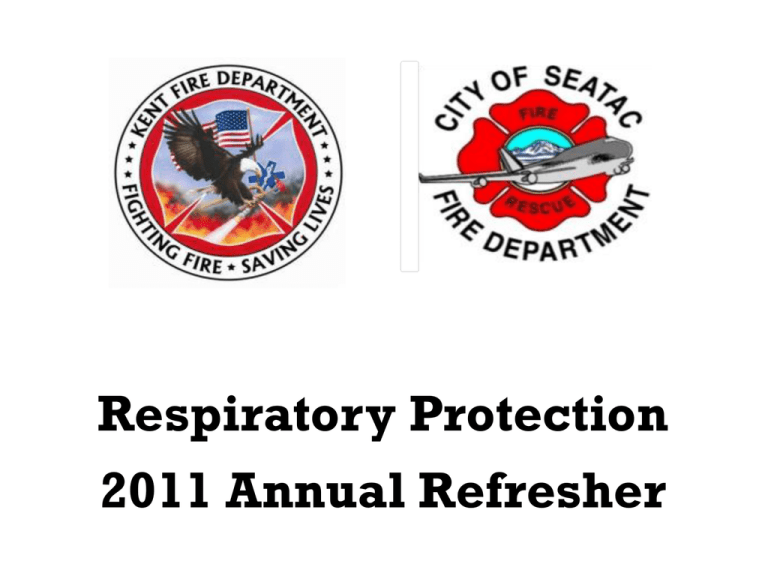
Respiratory Protection 2011 Annual Refresher Classroom, Written exam & Practical Demonstrate: 1. Why SCBA is necessary? 2. What are limitations – equipment , environment and user? 3. Maintence & Use 4. Emergency situations - failure 5. Knowledge of policy KFD and STFD The ONLY Approved Respiratory Equipment: MSA FireHawk SCBA- 2 versions, APR half-mask, P100, N95, PremAire Cadet SABA SCBA Mandatory use 1.All Fire Department Personnel shall wear SCBA when operating in any of the following atmospheres. a. Any IDLH atmosphere. b. An oxygen rich or deficient atmosphere. (Under 19.5%, Over 23.5% oxygen) c. An atmosphere of particulate, gas or vapor contaminants. ie: asbestos, CO, HCN SCBA Mandatory use d. In any permit-required confined space that has not been tested and monitored to establish respiratory safety. e. Any possible signs of WMD event. Gross Decon shall be performed prior to removal of face piece. SCBA Mandatory use 2. SCBA shall be used by all personnel who enter into hazardous atmospheres during structural firefighting activities or other IDLH or potential IDLH atmospheres, including: a. In an active fire area. b. Directly above a fire area. (vertical ventilation) c. Directly under the active area. d. In potential explosive or fire area, including gas leaks or fuel spills. SCBA Mandatory use e. Where products of combustion are visible in an atmosphere, including vehicle fires and dumpster fires. f. Where invisible contaminants are present or suspected. This includes the overhaul stage of a fire. g. Where toxic products are present, suspected of being present, or may be released without prior warning. h. In an active chemical spill area where the chemical presents an inhalation hazard. SCBA Mandatory use • SCBA use is mandatory if you are working in atmospheres where CO, HCN and other toxic gasses are suspected to be above safe levels. • Fiberglass dust and other particles in the air, or suspected in the air, require SCBA use. APR, P100 and N95 use When transporting an individual with suspected or confirmed infectious tuberculosis or meningococcal bacterium or other infectious air borne illness, (H5N1, H1N1) even if individual is masked. Neither P100 nor N95 may be used for overhaul. 10 second seal check • WAC 296-842-22020 states: Prior to each use the unit must be checked to ensure that a proper seal is achieved. A 10 second negative pressure seal check is required. • The best way to do this is with your 2nd stage regulator. • Change for STFD, new SOG 5.2.0 Hazardous atmospheres members may be exposed to during Routine and Emergency Operations: • Oxygen deficient • Aerosols • Gaseous • Elevated temperatures • Flashover • Irritant particles • Toxic gases •Unknown •Overhaul operations Cleaning the SCBA • • • Keep water out of 2nd stage regulator. Use brush, check bell for sheet rock. Hang to air dry. Cleaning the Face Piece 1. Remove accessories (HUD receiver and ClearCommand amp) before starting 2. Water temperature below 120 degrees 3. Rinse large debris off with water 4. Wash with disinfectant provided at stations (no alcohol on facepiece) 5. Confidence Plus- ½ oz in a gallon of water or use spray bottles provided. 6. Rinse with water 7. Towel and AIR DRY- hung upside down. User Limitations • Physical condition – maximize work effort • Agility – restrictive movements • Facial Features – seal issues • Contact Lenses – otherwise glasses inserts are provided • Respiratory – any smokers? • Mental – training, confidence, “cool” Equipment Limitations • Limited visibility – peripheral vision is reduced, fogging • Communication – failures of lapel mics, amplifiers not turned on. • Weight – 25-35 extra pounds • Mobility – backpack and straps reduce ability to move freely • Equipment malfunction – Know what to do if your equipment suddenly malfunctions Environmental Limitations • Cold Weather – water spray from fire fighting activities can cause SCBA to freeze up and not function properly. • Chemicals – while the SCBA protects your respiratory system, many chemicals are absorbed through your skin. DECON. • Extreme Heat – Elevated temperatures such as flashover may damage SCBA beyond use. Air Supply Limitations • “30 minute” bottle = 45 cubic feet, 20 – 25 minutes working time. • “45 minute” bottle = 66 cubic feet, less than 40 minutes working time. • “1 hour” bottle = 88 cubic feet, less than 45 minutes working time. (Haz-Mat & RIT/RIC) • SABA – Supplied Air Breathing Apparatus for Confined Space rescue, has 10 or15 minute escape pack AIR CYLINDER Level 1 damage: OK to continue using. Level 2 damage: Circle damage with permanent marker and send in for repair. (Station 45 or Station 75) Level 3 damage: Not repairable. Must be taken out of service. FIRST STAGE REGULATOR Audi-larm Note: NO URC on STFD • Audi-Larm Rings at 25% of service pressure remaining - approximately 1,125 psi • O-ring must be seated at connection from cylinder to coupling nut. Daily check! • URC must be checked for tightness. Place out of service if loose. Second Stage Regulator 1000 pound rating on top loop. Not for hoisting. 500 pound rating on each side handle. Carrier and Harness URC Universal Rescue Connection STFD has only chest URC. ICM or ICM-Tx - PASS device All Gauges should read within 5% of each other. Place out-of-service if difference is +/- 225 psi. Heads-Up Display (HUD) To remove HUD for cleaning or to change batteries, turn this thumbscrew. HUD DISPLAY CHART 20 seconds on ¾ to ½ 20 seconds on 30 seconds flashing on/off ½ to ¼ ¼ till gone Orange Light Pre-Alarm for ICM Tx Unit Flashing continuously Low Battery Warnings: HUD – single yellow ICM Tx – double short yellow Emergency Operations Buddy Breathing vs. Transfill. Buddy Breathing is sharing a regulator. Note: Offset placement of regulator to mask Transfilling uses hose or RIT/RIC kit to URC to equalize the pressures of both cylinders. RIT/RIC Kit • • • • • Every apparatus will have a RIT/RIC kit 3 or 6 foot trans-fill hose Mask is attached to 2nd stage regulator May crack open bypass for unconscious It is normal to have a slight positive pressure to the mask when bottle is turned on. Setup is exactly the same. Similar tools.
